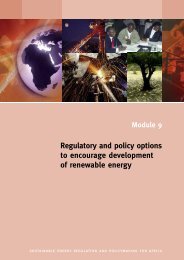Increasing access to energy services in rural areas - REEEP ...
Increasing access to energy services in rural areas - REEEP ...
Increasing access to energy services in rural areas - REEEP ...
You also want an ePaper? Increase the reach of your titles
YUMPU automatically turns print PDFs into web optimized ePapers that Google loves.
MODULE 10: INCREASING ACCESS TO ENERGY SERVICES IN RURAL AREAS<br />
page 10.67<br />
Conclusion<br />
The development of <strong>rural</strong> electrification plann<strong>in</strong>g and criteria <strong>to</strong> aid plann<strong>in</strong>g is a complex<br />
subject. The aim <strong>in</strong> this document is <strong>to</strong> present an example of a relatively simple and transparent<br />
process that could be used for <strong>rural</strong> electrification plann<strong>in</strong>g. The process described<br />
follows a five-stage filter<strong>in</strong>g process:<br />
• Identification of priority development nodes, usually political priorities and part of a<br />
national development plan;<br />
• Technology mapp<strong>in</strong>g based on least-cost supply and life-cycle criteria;<br />
• Project identification, cluster<strong>in</strong>g and cost<strong>in</strong>g based on criteria for f<strong>in</strong>ancial viability;<br />
• Project prioritization based on economic criteria;<br />
• Adjustment for regional equity based on political imperatives.<br />
While the cost<strong>in</strong>g, f<strong>in</strong>ancial viability and economic criteria are obviously very important, a<br />
simplified economic benefit po<strong>in</strong>ts (BP) system can also be developed <strong>to</strong> make the system<br />
more transparent. The economic benefit po<strong>in</strong>ts allocation should be based on sec<strong>to</strong>ral priorities<br />
<strong>in</strong> local government, health, education, agriculture and water sec<strong>to</strong>rs covered <strong>in</strong> the<br />
national development plans, poverty eradication documents, etc.<br />
References<br />
Banks D I, 1999. Grid or off-grid settlement electrification Decisions, Criteria and<br />
Processes, Domestic Use of Energy Conference, Cape Town<br />
Banks D I, 2000. Electrification Modell<strong>in</strong>g for South Africa, Discussion of the methodology<br />
employed. Prepared for: DBSA, Eskom, DME. RAPS, Pre<strong>to</strong>ria.<br />
Banks D I, “Criteria <strong>to</strong> support project identification <strong>in</strong> the context of <strong>in</strong>tegrated grid and<br />
off-grid electrification plann<strong>in</strong>g”. Energy & Development Research Centre, University<br />
of Cape Town. 1998.<br />
Banks, D I Mocke F, Jonck E C, Labuschagne E L, Eberhard, R., 2000. Electrification Plann<strong>in</strong>g<br />
Decision Support Tool, Domestic Use of Energy Conference, Cape Town<br />
Foley G, 1992. Rural electrification <strong>in</strong> the develop<strong>in</strong>g world, Butterworth-He<strong>in</strong>emann Ltd.<br />
Galen, P S, 1997, Electrification Decisions Po<strong>in</strong>ts Report, Prepared for Development Bank<br />
of Southern Africa, and Energy and Development Research Centre<br />
Grierson J P, Determ<strong>in</strong>ed Entrepreneurs, Susta<strong>in</strong>able Development, Swiss Centre for<br />
Development Cooperation <strong>in</strong> Technology and Management (SKAT), St. Gallen,<br />
Switzerland.<br />
Horvei T and Dhal H-E, :Rural Electrification <strong>in</strong> the Southern Africa Region: A Comparative<br />
analysis of objectives and experiences”. World Energy Council, Regional forum<br />
Southern and East Africa










